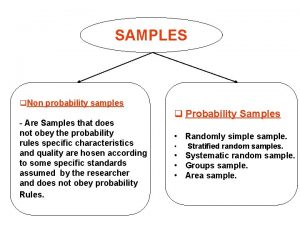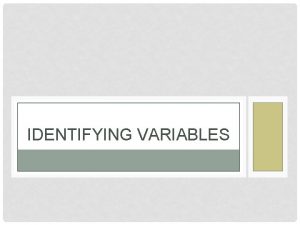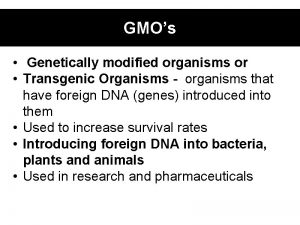Terms Populations versus samples Populations of organisms vary



















- Slides: 19

Terms • Populations versus samples – Populations of organisms vary in characteristics • Weight, growth rate, size – Statistics enable summarization of characteristics • Takes a sample from the population – ****MUST BE RANDOM**** » All individuals have equal chance of being chosen – Larger the better • Enable us to determine whether two populations are statistically different 1

• A parameter is a numeric quantity – usually unknown – describes a certain population characteristic – Ex. Mean and median – Represented by Greek letters • μ • A statistic is a quantity, calculated from a sample of data, used to estimate a parameter – Ex. Mean 2

Mean • Most commonly used parameter to describe the central tendency of a population • Parameter: μ (true mean) • Statistic: 3

Median • • Think middle of the road Another measure of central tendency Middle measurement in ranked listing If there is even number of individuals in the sample, median is mean of the two middle measurements 4

• When it might be better to use the median to describe the central tendency: – OUTLIERS! 11, 12, 13, 14, 15, 14, 16, 18, 13, 110 5

Variability • How data falls around the mean Sample 1 9 22 16 13 11 19 Mean = 15 Sample 2 15 16 17 15 13 14 Mean = 15 6

Histograms are a good way of displaying variability 7

• Range is one measure of data variability – Difference between the largest and the smallest measurement • Ex. Range (9, 22) for Sample 1 • Range gives us a good “eyeball” estimate for variability BUT: – Range almost always underestimates actual population range 8

Sum of Squares • More accurate method of estimating variation from the mean is the standard deviation • Sum of Squares SS = Σ(X – )2 9

Sum of Squares example Sample 1 9 22 16 13 11 19 Mean = 15 SS = Σ(X – )2 (9 -15)2 (22 -15)2 (16 -15)2 (13 -15)2 (11 -15)2 (19 -15)2 122 ***Why is it important that we square the values? 10

• Try it with sample 2 – What is the sum of squares value? 11

SS= 10 12

Variance (s 2) • Value from SS can be used to calculate the sample variance s 2 = SS/DF DF= Degrees of freedom (n-1) n is the number of samples Ex. Sample 1 has n=6, n-1=5 ***DF will be n-1 13

• What is variance for Sample 2? 14

2 s =2 15

Standard Deviation (s) • Report the standard deviation, rather than the sample variance ***Shows us the variability in samples*** s or SD = 2 16

• What is SD or s of sample 2? 17

s= 1. 41 18

Why is this important? • STDEV and relationship with mean – Histogram on board • Sample 2 had s= 1. 41 • Sample 1 had s= 4. 94 – SS=122 – s 2 = 122/5= 24. 4 – Square root of 24. 4= 4. 94 19
 Member of the same species
Member of the same species Unicellular vs multicellular activity
Unicellular vs multicellular activity Skeletal root words
Skeletal root words Polynomial degrees and terms
Polynomial degrees and terms Like terms in algebra
Like terms in algebra Citl ucsc
Citl ucsc Species vary locally
Species vary locally Artificial selection
Artificial selection Vary sentence length example
Vary sentence length example Why does development vary among countries
Why does development vary among countries Vary your sentences
Vary your sentences Vary sentence structure
Vary sentence structure Key issue 3: why do individual languages vary among places?
Key issue 3: why do individual languages vary among places? Why does population growth vary among regions
Why does population growth vary among regions Pematex karlovy vary
Pematex karlovy vary How much does the fat content of brand x hot dogs vary
How much does the fat content of brand x hot dogs vary Why is it important to vary your sentences structures
Why is it important to vary your sentences structures Adj of vary
Adj of vary Answers vary
Answers vary Some prepositions show time and place and others add detail
Some prepositions show time and place and others add detail




































